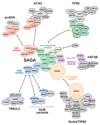Sharing the SAGA
- PMID: 28964624
- PMCID: PMC5660625
- DOI: 10.1016/j.tibs.2017.09.001
Sharing the SAGA
Abstract
Transcription initiation is a major regulatory step in eukaryotic gene expression. Co-activators establish transcriptionally competent promoter architectures and chromatin signatures to allow the formation of the pre-initiation complex (PIC), comprising RNA polymerase II (Pol II) and general transcription factors (GTFs). Many GTFs and co-activators are multisubunit complexes, in which individual components are organized into functional modules carrying specific activities. Recent advances in affinity purification and mass spectrometry analyses have revealed that these complexes often share functional modules, rather than containing unique components. This observation appears remarkably prevalent for chromatin-modifying and remodeling complexes. Here, we use the modular organization of the evolutionary conserved Spt-Ada-Gcn5 acetyltransferase (SAGA) complex as a paradigm to illustrate how co-activators share and combine a relatively limited set of functional tools.
Keywords: assembly; chromatin; functional module; multisubunit complex; protein–protein interaction; transcription.
Copyright © 2017 Elsevier Ltd. All rights reserved.
Figures

Similar articles
-
What do the structures of GCN5-containing complexes teach us about their function?Biochim Biophys Acta Gene Regul Mech. 2021 Feb;1864(2):194614. doi: 10.1016/j.bbagrm.2020.194614. Epub 2020 Jul 31. Biochim Biophys Acta Gene Regul Mech. 2021. PMID: 32739556 Review.
-
Sus1p facilitates pre-initiation complex formation at the SAGA-regulated genes independently of histone H2B de-ubiquitylation.J Mol Biol. 2014 Aug 12;426(16):2928-2941. doi: 10.1016/j.jmb.2014.05.028. Epub 2014 Jun 6. J Mol Biol. 2014. PMID: 24911582 Free PMC article.
-
Actively transcribed GAL genes can be physically linked to the nuclear pore by the SAGA chromatin modifying complex.J Biol Chem. 2007 Feb 2;282(5):3042-9. doi: 10.1074/jbc.M608741200. Epub 2006 Dec 6. J Biol Chem. 2007. PMID: 17158105
-
Combinatorial depletion analysis to assemble the network architecture of the SAGA and ADA chromatin remodeling complexes.Mol Syst Biol. 2011 Jul 5;7:503. doi: 10.1038/msb.2011.40. Mol Syst Biol. 2011. PMID: 21734642 Free PMC article.
-
Function and regulation of the Spt-Ada-Gcn5-Acetyltransferase (SAGA) deubiquitinase module.Biochim Biophys Acta Gene Regul Mech. 2021 Feb;1864(2):194630. doi: 10.1016/j.bbagrm.2020.194630. Epub 2020 Sep 8. Biochim Biophys Acta Gene Regul Mech. 2021. PMID: 32911111 Review.
Cited by
-
The SAGA continues: The rise of cis- and trans-histone crosstalk pathways.Biochim Biophys Acta Gene Regul Mech. 2021 Feb;1864(2):194600. doi: 10.1016/j.bbagrm.2020.194600. Epub 2020 Jul 6. Biochim Biophys Acta Gene Regul Mech. 2021. PMID: 32645359 Free PMC article. Review.
-
Epigenetic Signaling in Glia Controls Presynaptic Homeostatic Plasticity.Neuron. 2020 Feb 5;105(3):491-505.e3. doi: 10.1016/j.neuron.2019.10.041. Epub 2019 Dec 3. Neuron. 2020. PMID: 31810838 Free PMC article.
-
A synthetic non-histone substrate to study substrate targeting by the Gcn5 HAT and sirtuin HDACs.J Biol Chem. 2019 Apr 19;294(16):6227-6239. doi: 10.1074/jbc.RA118.006051. Epub 2019 Feb 25. J Biol Chem. 2019. PMID: 30804216 Free PMC article.
-
The role of SAGA coactivator complex in snRNA transcription.Cell Cycle. 2018;17(15):1859-1870. doi: 10.1080/15384101.2018.1489175. Epub 2018 Aug 15. Cell Cycle. 2018. PMID: 29995556 Free PMC article.
-
Chromatin remodeling by Pol II primes efficient Pol III transcription.Nat Commun. 2023 Jun 16;14(1):3587. doi: 10.1038/s41467-023-39387-4. Nat Commun. 2023. PMID: 37328480 Free PMC article.
References
-
- Muller F, et al. Developmental regulation of transcription initiation: more than just changing the actors. Current opinion in genetics & development. 2010;20:533–540. - PubMed
Publication types
MeSH terms
Substances
Grants and funding
LinkOut - more resources
Full Text Sources
Other Literature Sources
Molecular Biology Databases
Research Materials

